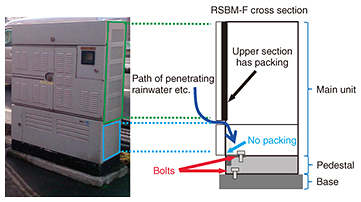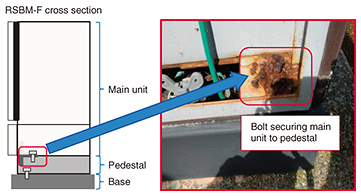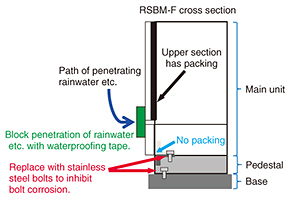 |
|
|
|
|
|
Practical Field Information about Telecommunication Technologies Vol. 15, No. 4, pp. 61–64, Apr. 2017. https://doi.org/10.53829/ntr201704pf1 Case Study of Bolt Corrosion in Remote Subscriber Module-Feeder PointAbstractThis article describes causes of and countermeasures to corrosion in bolts used for securing RSBM-F (remote subscriber module-feeder point) equipment. This is the thirty-ninth article in a series on telecommunication technologies. This contribution is from the Materials Engineering Group, Technical Assistance and Support Center, Maintenance and Service Operations Department, Network Business Headquarters, NTT EAST. Keywords: RSBM-F, bolt corrosion, countermeasures to corrosion 1. IntroductionToday’s information and communication services are supported by various facilities including radio towers, utility poles, conduits, manholes, and tunnels. Among these, the remote terminal box (RT-BOX) and remote subscriber module (RSBM) play important roles in accommodating and multiplexing public and leased circuits and connecting them using optical fiber to NTT buildings. In particular, the remote subscriber module-feeder point (RSBM-F) has been installed at wiring points with the aim of converting metal cables to optical fiber. This equipment is installed outdoors and is therefore continuously exposed to a variety of environmental conditions such as wind, rain, and airborne salt. This makes periodic inspection of such facilities all the more important. The RSBM-F is subject to inspections just as with other NTT facilities, and the facility inspection manual includes checks for abnormal operation of the RSBM-F main unit as well as other inspection items such as equipment doors and covers. However, no particular inspection method is specified for the steel bolts used to secure the RSBM-F equipment to the ground, and since these bolts are situated in locations that cannot be viewed from outside the equipment, they can be overlooked at the time of an inspection. These steel bolts are made of iron and therefore naturally generate concerns about corrosion-related deterioration due to the effects of the surrounding environment. Bolts that are deteriorating because of corrosion lose their ability to safely secure the equipment, so countermeasures are necessary to maintain their strength. The Materials Engineering Group of the Technical Assistance and Support Center has investigated past occurrences of bolt corrosion in RSBM-F equipment. In this report, we introduce a case study of bolt corrosion in RSBM-F and describe its causes and countermeasures. 2. RSBM-F configurationAn RSBM-F consists of a main unit, pedestal, and base (Fig. 1). The main unit has upper and lower sections. The upper unit contains communication wiring, whereas the lower unit does not. The pedestal is a steel component used for securing the main unit to the concrete base.
There are two doors for maintenance purposes on the side of the RSBM-F (indicated by the colored rectangles on the left side of Fig. 2). The door to the upper section of the main unit that houses communication wiring includes packing that hinders the inflow of moisture such as rainwater or snowmelt from the outside. In contrast, the door to the lower section of the main unit, which houses no communication wiring, does not include packing. Opening the lower door brings a bolt into view (Fig. 2, right; Fig. 3). This bolt secures the main unit to the pedestal and is positioned in an easy-to-reach location. There is also a bolt beneath the above bolt for securing the pedestal to the concrete base (Fig. 2, right). This bolt, however, is situated in a recessed location, making its maintenance quite difficult.
3. Causes of bolt corrosionAlthough inexpensive and high-strength material known as carbon steel is now commonly used for steel bolts, it is more susceptible to corrosion compared with the stainless steel used for the RSBM-F enclosure. Because the door to the lower section of the main unit does not include packing, moisture such as rainwater or snowmelt can penetrate the main unit from that section (right side of Fig. 2). Moreover, because this door is normally closed, any moisture that penetrates this section cannot easily evaporate due to poor ventilation and shaded conditions. Thus, if such moisture from the outside gets into the area surrounding the bolt, it will tend to accumulate, thereby hastening bolt corrosion. In addition, RSBM-F equipment installed in coastal regions may suffer from the penetration of saline matter from the ocean, while those installed along highways in regions with heavy snowfall may be affected by the penetration of chloride from snow-melting agents. Chemical solutions containing chloride are highly conductive, promoting the ionization of steel and accelerating corrosion. In particular, if corrosion of the bolt head progresses to a point of layered rusting, the bolt may expand and crack and then start to crumble as it loses its strength, making it difficult to remove (Fig. 3). 4. Countermeasures to bolt corrosionIf bolt corrosion progresses to the extent that the fixing ability of the bolt begins to deteriorate, the equipment runs the risk of shifting from its original position, and in the worst case, collapsing. Countermeasures to corrosion are therefore needed. We consider here two corrosion countermeasures, one on the equipment side and one on the bolt side (Fig. 4).
The countermeasure on the equipment side is to stop the moisture from penetrating the equipment. This can be accomplished, for example, by affixing waterproofing tape to the gaps surrounding the lower door to block the path of moisture. The countermeasure on the bolt side, meanwhile, is to replace the bolt material with something that is more corrosion-resistant. This could be stainless steel (SUS430, SUS304, etc.), which would inhibit bolt corrosion. 5. Future bolt corrosion countermeasuresPresently, no specific methods for inspecting RSBM-F steel bolts are described in facility inspection manuals, but it is nevertheless important that they be inspected together with other equipment inspection work. That is, when carrying out an RSBM-F inspection, the maintenance door on the side of the main unit should be opened and the state of the bolts visually checked. If corrosion is observed on a bolt, that bolt should then be replaced with a new one. Additionally, the use of stainless-steel bolts is recommended in order to suppress bolt deterioration by corrosion. However, if bolt corrosion at the time of a visual inspection has progressed as far as that shown in Fig. 3, it will be difficult to remove that bolt using an ordinary wrench. In such cases, a commercially available rusted-bolt removal tool can be used, or a method of destroying the bolt itself with a hammer or other tool to extract it can be considered. There are cases, however, in which a corroded bolt cannot be replaced by the above methods or in which the bolt connecting the pedestal and concrete base cannot be replaced because of its difficult-to-reach location. A technique that can be considered for such situations is to use backing plates applied to the outside of the RSBM-F enclosure to provide new screw holes for securing bolts. We plan to conduct trials to study the effectiveness of this approach (Fig. 5).
6. ConclusionIn this report, we described causes of and countermeasures to corrosion in bolts used for securing RSBM-F equipment. Since bolt corrosion progresses as a result of moisture penetrating the equipment from the outside, it is necessary to either replace the bolts themselves with corrosion-resistant stainless steel bolts or to block the path of penetrating moisture. In future studies, we plan to examine methods for removing substantially corroded and deformed bolts and a method for providing new bolt-fixing locations by using backing plates applied to the outside of the RSBM-F enclosure. |





